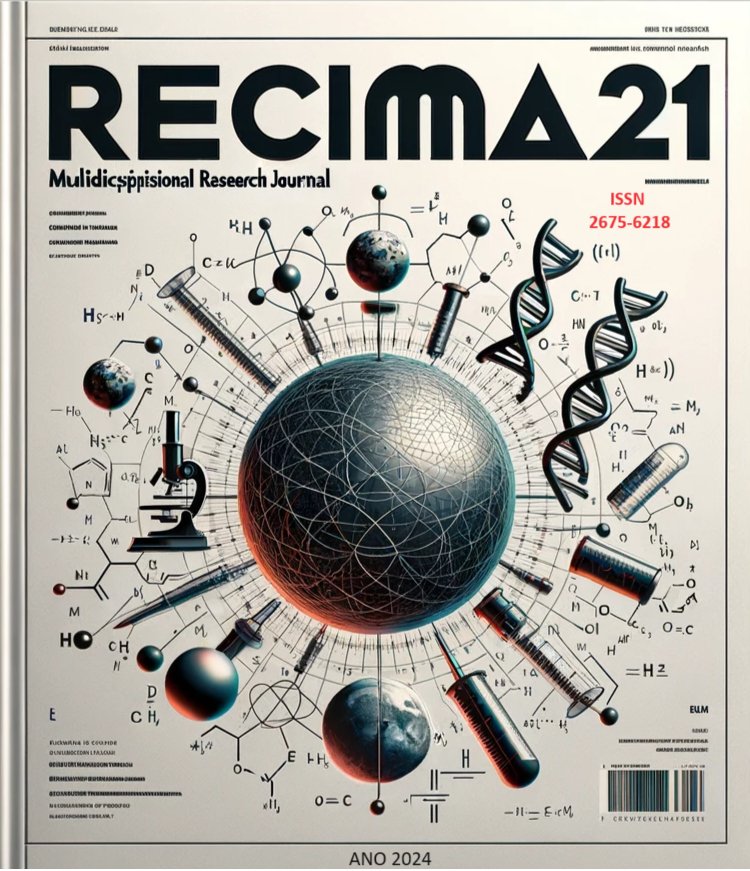TREINAMENTO FUNCIONAL RESISTIDO E SUA INFLUÊNCIA NA MELHORA DA PERFORMANCE DE CORREDORES
DOI:
https://doi.org/10.47820/recima21.v5i4.5153Palavras-chave:
Treinamento Funciona Resistido. Performance. Periodização. Desempenho em Corrida. Treinamento Esportivo.Resumo
O presente trabalho intitulado "Treinamento funcional resistido e sua influência no ganho de performance em corredores" tem como objetivo avaliar, através de uma criteriosa revisão bibliográfica, a influência do treinamento funcional resistido no ganho de performance de corredores. A pergunta norteadora deste trabalho é: "Como o treinamento funcional resistido auxilia na melhora da performance de corredores e quais estratégias para otimizar esse processo?". Em busca das respostas para essa questão, foram revistos diversos estudos científicos relacionados ao tema. Os resultados encontrados apontam para a eficácia do treinamento funcional resistido na melhora da performance dos corredores. Entre os benefícios destacados estão: aumento da força muscular, melhor equilíbrio, coordenação motora aprimorada e prevenção de lesões. Espera-se que este trabalho contribua para a compreensão sobre a importância do treinamento funcional resistido na preparação dos corredores. Além disso, pode servir como base para futuros estudos sobre estratégias eficientes visando aumentar o desempenho esportivo desses atletas.
Downloads
Referências
ARAZI, H.; MIRZAEI, B.; NOBARI, H. On the compatibility of endurance and strength training modes of exercise. MOJ Sports Medicine, v. 1, n. 3, p. 00016, 2017.
BALSALOBRE-FERNANDEZ, C.; SANTOS-CONCEJERO, J.; GRIVAS, G. V. Effects of strength training on running economy in highly trained runners: a systematic review with meta-analysis of controlled trials. Journal of Strength and Conditioning Research, v. 30, n. 8, p. 2361-2368, 2016. DOI: https://doi.org/10.1519/JSC.0000000000001316
BALSAMO, S.; TIBANA, R. A.; NASCIMENTO, D. C.; PETRUCCELLI, Z. D.; PRESTES, J.; DE SANTANA, F. S. Exercise order affects the total training volume and the ratings of perceived exertion in response to a super-set resistance training session. International Journal of General Medicine, v. 6, n. 123, 2013. DOI: https://doi.org/10.2147/IJGM.S27377
BERRYMAN, N.; MUJIKA, I.; ARVISAIS, D.; ROUBEIX, M.; BINET, C.; BOSQUET, L. Strength Training for Middle- and Long-Distance Performance: A Meta-Analysis. International Journal of Sports Physiology and Performance, v. 13, n. 1, p. 57–63, 2018. DOI: https://doi.org/10.1123/ijspp.2017-0032
DAMASCENO, M. V.; LIMA-SILVA, A. E.; PASQUA, L. A.; TRICOLI, V.; DUARTE, M.; BISHOP, D. J. et al. Effects of resistance training on neuromuscular characteristics and pacing during 10-km running time trial. European Journal of Applied Physiology, v. 118, n. 7, p. 1513-1522, 2018. DOI: https://doi.org/10.1007/s00421-015-3130-z
GOMES, G. V.; REIS, E. K.; CARVALHO JUNIOR, A. D.; BALSAMO, S. Influence of functional training on the variations of the center of pressure in different surfaces and visual conditions with open and closed eyes for elderly individuals: controlled clinical trial protocol. [S. l.: s. n.], 2015.
GONZÁLEZ-BADILLO, J. J.; SÁNCHEZ-MEDINA, L. Movement velocity as a measure of loading intensity in resistance training. International Journal Sports Medicine, n. 37, p. 03, p. 217-22, 2016.
GREENFIELD, B.; CATLIN, P. A.; COATS, J.; GREEN, E.; MCDONALD, J.; NORTHUP, G. Postural control in women with multiple sclerosis: Effects of task, vision and symptomatic fatigue. Gait & Posture, v. 62, p. 505-511, 2018.
JONES, T. W.; HOWATSON, G.; RUSSELL, M.; FRENCH, D. N. Performance and neuromuscular adaptations following differing ratios of concurrent strength and endurance training. Journal of Strength and Conditioning Research, v. 27, n. 12, p. 3342-3351, 2013. DOI: https://doi.org/10.1519/JSC.0b013e3181b2cf39
KARSTEN, B.; STEVENS, L.; COLPUS, M.; LARUMBE-ZABALA, E.; NACLERIO, F. The effects of sport-specific drills training or high-intensity interval training in young well-trained soccer players. Journal of Strength and Conditioning Research, v. 31, n. 2, p. 368-375, 2016.
LOTURCO, I.; PEREIRA, L. A.; CAL ABAD, C. C.; D'ANGELO, R. A.; FERNANDES, V.; KITAMURA, K.; NAKAMURA, F. Y. Vertical and horizontal jump tests are strongly associated with competitive performance in 100-m dash events. Journal of Strength and Conditioning Research, v. 30, n. 7, p. 1966-1971, 2016. DOI: https://doi.org/10.1519/JSC.0000000000000849
MCMILLIAN, D. J.; MOORE, J. H.; HATLER, B. S.; TAYLOR, D. C. Dynamic vs. static-stretching warm up: the effect on power and agility performance. Journal of Strength and Conditioning Research, v. 20, n. 3, p. 492-499, 2016. DOI: https://doi.org/10.1519/00124278-200608000-00006
PAGE, P.; FRANK, C. C.; LARDNER, R. Assessment and Treatment of Muscle Imbalance: The Janda Approach. Human Kinetics, 2010. DOI: https://doi.org/10.5040/9781718211445
PAOLI, A.; MORO, T.; BIANCO, A. Lift weights to fight overweight. Clinical Physiology and Functional Imaging, v. 37, n. 1, p. 1-6, 2017. DOI: https://doi.org/10.1111/cpf.12136
SILVA, N. L.; OLIVEIRA, R. B.; FLECK, S. J.; LEON, A. C. M. R.; FARINATTI, P. Influence of strength training variables on strength gains in adults over 55 years-old: a meta-analysis of dose-response relationships. Journal of Science and Medicine in Sport, 2016.
Downloads
Publicado
Licença
Copyright (c) 2024 RECIMA21 - Revista Científica Multidisciplinar - ISSN 2675-6218

Este trabalho está licenciado sob uma licença Creative Commons Attribution 4.0 International License.
Os direitos autorais dos artigos/resenhas/TCCs publicados pertecem à revista RECIMA21, e seguem o padrão Creative Commons (CC BY 4.0), permitindo a cópia ou reprodução, desde que cite a fonte e respeite os direitos dos autores e contenham menção aos mesmos nos créditos. Toda e qualquer obra publicada na revista, seu conteúdo é de responsabilidade dos autores, cabendo a RECIMA21 apenas ser o veículo de divulgação, seguindo os padrões nacionais e internacionais de publicação.













